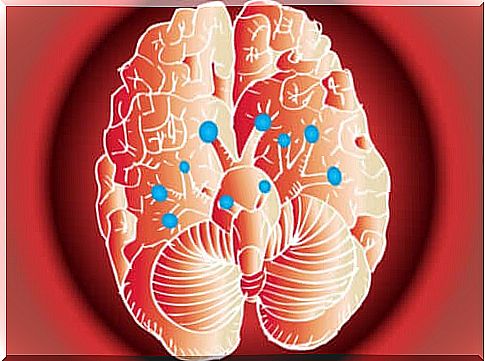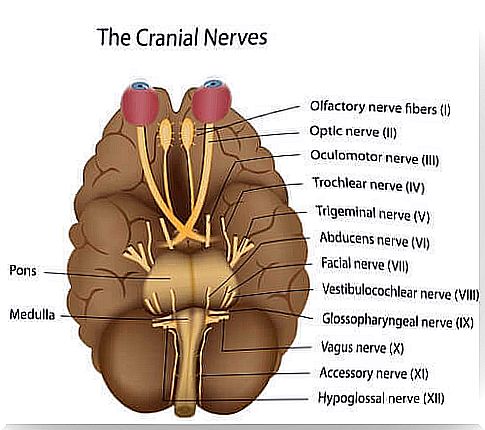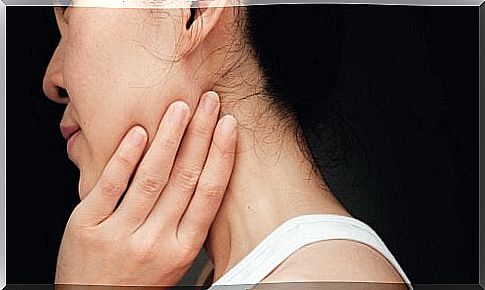The 12 Cranial Nerves And Their Functions

The complexity of the nervous system is immense. Its multiple connections make this system one of the most important in our body. In this article we’re going to talk about several of its most important pathways: the cranial nerves.
Cranial nerves or pairs emerge from the base of the skull and reach their target areas through holes distributed in it. So they communicate with peripheral areas.
Its name is due to the fact that there is a nerve on each side of the brain. So there are twelve nerves in the right hemisphere and twelve nerves in the left.
Cranial nerve classification
Cranial nerves can be classified in different ways:
- According to your role.
- Cranial motor nerves . There are cranial nerves related to eye movements: three, four and five; and cranial nerves related to tongue and neck movements: ten and twelve.
- Cranial sensory nerves : one, two and eight.
- Cranial nerves mixed : five, seven, nine and ten.
- Cranial parasympathetic nerves : three and seven.
- According to your position. These are those above the brainstem (pairs one and two); those found in the upper part of the brainstem (pairs three and four); those near the bridge (pairs five, six, seven and eight); those in the lowest part of the spinal cord (pairs nine, ten, eleven and twelve).
According to Bear, Connors and Paradiso, authors of the book Neurosciences: Unraveling the Nervous System, the first two cranial nerves are part of the central nervous system and the others are like the spinal nerves, “in the sense that they contain axons of the peripheral nervous system” , although each nerve has fibers that perform varied functions.

Cranial nerves and their functions
first cranial nerve
Types of axons: special sensory.
It is the shortest cranial nerve, as its target area is close to the area from which it arises in the brain. It is also called the olfactory nerve. Furthermore, as the other name implies, it is responsible for transporting nervous information related to smell.
second cranial nerve
Types of axons: special sensory.
It originates in the diencephalon. Like the previous one, it has afferent fibers, that is, they transport nerve impulses from the sensory organs to the central nervous system. Its function is to convey visual information.
third cranial nerve
Types of axons: somatic motors and visceral motors.
It is called in two other ways: oculomotor nerve or common ocular motor nerve. It is responsible for eye and eyelid movement. Furthermore, it governs the parasympathetic control of pupil size.
fourth cranial nerve
Types of axons: somatic motors.
The fourth pair originates in the midbrain. It is called the trochlear nerve and the pathetic nerve. Also takes care of eye movement. Specifically, it sends signals to the superior oblique muscle of the eye.
fifth cranial nerve
Types of axons: sensory somatics and motor somatics.
Known as the trigeminal nerve. It has motor and sensory functions. At the motor level, it sends orders to the muscles responsible for chewing, and at the sensory level, it collects tactile, pain and proprioceptive information from the mouth and face.
sixth cranial nerve
Types of axons: somatic motors.
It’s called the abducens nerve. It is responsible for the abductor movements of the eye, that is, the one that makes the eye move towards the opposite side of the nose. Incredible!
seventh cranial nerve
Types of axons : sensory somatics and motor somatics.
Also known as facial pair. It is responsible for the movements of the muscles of facial expression. Furthermore, by the sense of taste in the anterior two thirds of the tongue. It also sends orders to the lacrimal and salivary glands.
eighth cranial nerve
Axon types: special sensory.
It’s the vestibulocochlear nerve. Take care of your sense of hearing and balance. Therefore, it receives information about what we have heard and where we are.
ninth cranial nerve
Types of axons : somatic motors, visceral motors, sensory sensors and special visceral ones.
Called the glossopharyngeal nerve. It is a mixed nerve, and from its name we could deduce some of its functions. We’ll see what they are:
- Throat muscle movement.
- Parasympathetic control of salivary glands.
- Detection of changes in blood pressure in the aorta.
- Taste sense, in the posterior third of the tongue.

tenth cranial nerve
Types of axons: visceral motors.
It’s called the vagus nerve. It is responsible for the parasympathetic control of the heart, lungs and abdominal organs, as well as the sensation of visceral pain, movement of the throat muscles, and receives information from the taste buds.
eleventh cranial nerve
Types of axons: somatic motors.
It’s called the accessory spinal nerve. It handles the movements of the muscles in the throat and neck.
twelfth cranial nerve
Types of axons: somatic motors.
Called a halibut. Participate in the action of swallowing. Furthermore, it is responsible for the movement of the tongue, working in conjunction with nerves nine and ten. Thanks to this pair, swallowing is performed optimally.
Any damage to the cranial nerves could pose a problem for our survival or for the functioning of our body. Above all, we can evidence neurological disorders.
We hope that, thanks to this journey, it has been possible to get to know this essential part of our body a little better.









